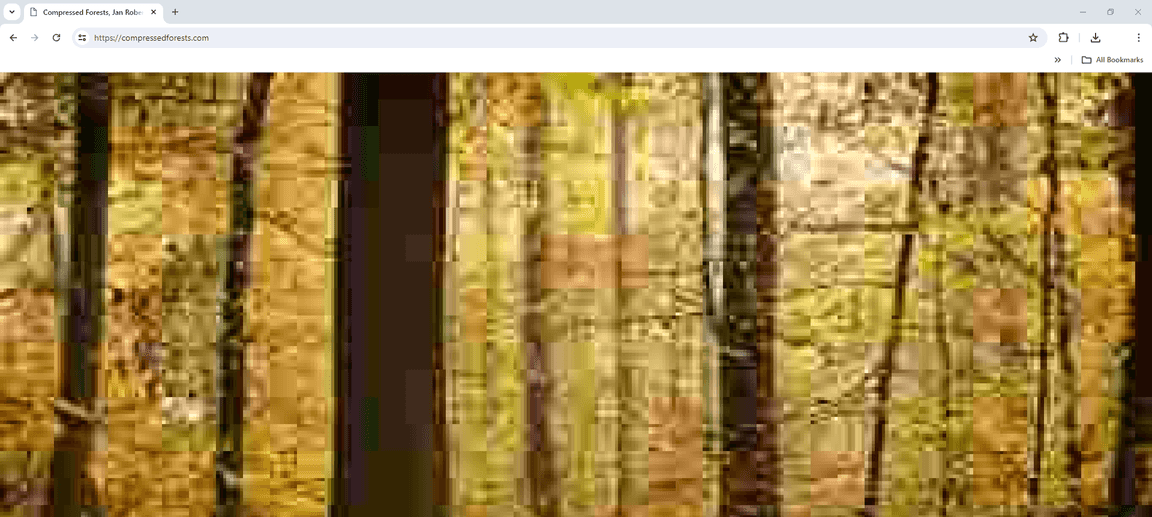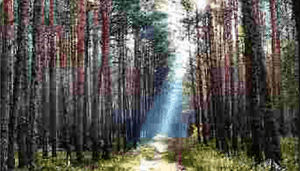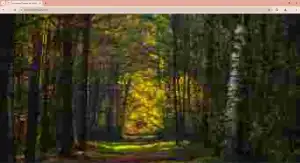
Compressed Forests (2016) - Jan Robert Leegte
In collection of the Cultural Heritage Agency and on permanent loan at the Centraal Museum.
This online artwork, selecting and compressing a continuous series of images from social media. Compressed Forests offers many preservation challenges based on its dependency on Flickr as an image source. At this time Flickr, as a proprietary platform for image hosting, has remained stable in its accessibility but this case study considered what the options may be in preserving the work when Flickr is no longer available.
Brief Description
Compressed Forests consists of a website that features pixelated images of forests retrieved from Flickr. Based on the image alteration employed by the Impressionists through their landscape paintings, images are selected from the Flickr database based on the use of the tags, “forest” or “trees,” and then submitted to a large degree of compression using the standard JPEG compression algorithm. The final effect, visible at compressedforests.com, shows extremely pixelated images that progress through in 60 second intervals, with a black screen briefly discernable in between.

Screenshot of Compressed Forests www. compressedforests.com
The Compressed Landscapes Series: Exhibition and Acquisition
The work is part of a series created by Leegte titled the Compressed Landscape series. It is made up of 5 works: Compressed Landscapes (2016), Compressed Mountains (2016), Compressed Sunsets (2016), Compressed Moons (2016) and Compressed Forests (2016). These works were collectively first presented at Upstream as part of a solo exhibition by Leegte titled, “Sculpting the Internet” (February 4th - March 11th 2017) where Compressed Forests was ultimately acquired by Pieter Sanders and Marieke Sanders-ten Holte (Sanders collection).
At the time the Sanders Collection purchased the work, Leegte was inspired by the wayRafaël Rozendaal had put together his acquisition contract, putting emphasis on the inclusion of deliverables. These deliverables, included the transfer of a Raspberry Pi and micro-SD card, containing two /versions of the work, as part of the acquisition. In 2018, Marieke Sanders-ten Holte donated the work, as part of a larger donation of contemporary works, to the Cultural Heritage Agency of the Netherlands (RCE) to be divided and issued on permanent loan to five institutions of Sanders-ten Holte’s choice. As part of this donation scheme Compressed Forests was given on permanent loan to the Utrecht Centraal Museum.
Understanding the Different Versions
In conjunction with the case study research, LI-MA received a total of three transfers from the Utrecht Centraal Museum and the artist with data and hardware composing and/or relating to the work. From these transfers it was determined that there were two main versions of Compressed Forests: an offline and an online version. The primary version, i.e. the online one, has two different implementations: the website, which has been accessible online since 2016, and the online version as it exists on the Raspberry Pi. The online version contained on the Raspberry Pi has almost the same source code as the website except for two key exceptions: the implementation on the Raspberry Pi contains an icon in the browser bar (favicon.ico) and the refresh time is 90 seconds instead of 60 seconds. The offline version, found also on the Raspberry Pi, contains entirely different source code than either implementation of the online version, largely as instead of drawing from Flickr it draws from an image archive containing 114 images stored on the included micro-SD card.

During the artist interview, Leegte discussed his thoughts on the offline version, influencing considerations regarding the work’s preservation. In his own words he described the Raspberry Pi as a “brick”, just a “carrier for the documentation version.” He elucidated that he included the Raspberry Pi and its contents in the acquisition only because it was one of the first internet artworks he ever sold and he was still experimenting with how best to transfer all aspects of the work. Regarding specifically the offline version, he discussed it as part of this experimentation in the work’s acquisition, but also as a draft for how to conserve the work for the future, in case Flickr should fail. Lastly, he talked about the importance he allocated to the Flickr API, which selects the images from Flickr, in giving the work its meaning.
To keep the website functional for as long as possible, it was necessary to address in some ways the work’s greatest dependency, which is the use of Flickr as a JPEG image source. Unfortunately, since Flickr is proprietary, there wasn’t much that could be done to prevent Flickr from making their image database inaccessible in the future, but reliance on the artist’s personal Flickr API key could be circumvented by creating a Flickr API key for the institutions. This was thus executed, along with the compilation of an offline image database, automatically downloaded from Flickr using the same algorithm.
Lastly there was the question of what to do with the offline version, that the artist simultaneously considered “dead” but also as a draft for how the work could be conserved. After several discussions with the stakeholders it was decided to keep the offline version, under the consideration that it be seen as documentation, a last alternative for when it is no longer possible for the work to be viewed as intended.
Hosting the Website and Expanding the Offline Version
The insight provided by the artist in the interview follows the observations made early on in this summary regarding the difficulty of using web archiving strategies to address the preservation of internet artworks. The exclusion of these strategies leave only one option to preserve the work as intended, which is to host the website while providing regular maintenance. To do this, LI-MA provides a service, specifically equipped for hosting web-based artworks, called ArtHost.
ArtHost provides each artwork with its own special environment using virtual machines, which make it easier to maintain, migrate, backup or restore artworks contained therewith. Visitors from the internet can access the virtual machines via a proxy server which handles the communication between the user requests and the machine, ensuring the accessibility of the artwork. Arthost further maintains the domain name subscription to prevent the loss of important historical context.
Diagram depicting how the online version works as compared to the offline version
To best preserve the work, both versions were uploaded to ArtHost and the source code along with the 114 images received with the offline version were placed in LI-MA’s digital repository and stored in git. Further, following standard guidelines upheld by the National Digital Stewardship Alliance regarding the creation and storage of multiple copies across more than one physical location, the source code was also uploaded to gitlab. In line with the artist’s concept of the offline version as a long-term preservation draft, it was decided to expand the archive of 114 images, included by the artist, to be more representative, in case of a scenario when it becomes the sole documentation of the work. The term representative here refers to the work’s geolocational and seasonal dependency, where the images change based on where or in what season the work is accessed. While it was not possible to create an image dump for every place, it was decided to create one for each season.
The last step, which has yet to be executed, is to provide a split screen video of the artist interacting with the work. In this way a video registration will be created with the aim of how the work functions at a given time, recording what is the expected functionality of the website according to the artist while giving them a platform to briefly discuss their intention with the work.
Access to the case study report, interview, and object-related documents is available on request (info@li-ma.nl).
Research by LI-MA team in collaboration with: Jan Robert Leegte (Artist), Dorian Meijnen (Junior curator, RCE), Sylvia van Schaik (Curator, RCE) and Arthur van Mourik (Collections Manager Centraal Museum).









